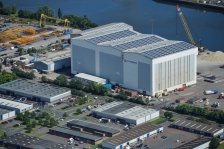
Commercial Rooftops - The Next Phase in the Solar Revolution
With solar farms increasingly dividing local communities, the Government has made it very clear that it wants to see fewer large-scale ground mounted solar developments encroaching onto productive arable land.
The Department of Energy & Climate Change (DECC) says it wants to encourage the development of smaller scale and community energy production. DECC’s latest proposals, unveiled in May, to close the Renewables Obligation (RO) for solar farms larger than 5MW in capacity came as a shock. Any changes to the subsidy regime are not due to come into effect until 1 April 2015.
Further evidence of the Government’s determination to shift solar developments onto rooftops emerged in July when the Minister of State at the time, Greg Barker announced: “My personal ambition is to see 20GW of solar deployed, here in the UK, early in the next decade. I want the lion’s share of that to be deployed on previously used, rather than greenfield land. That means disused airfields, old mines, car parks, waste sites. It means unproductive bits of Government land … and it means roofs. Commercial roofs. Industrial roofs. Domestic roofs.”
The change in focus is undoubtedly politically motivated. The public would prefer to see solar on roofs, rather than displacing green fields and agriculture, or in areas of natural beauty. However, there are practical reasons why locating solar on commercial rooftops makes sense:
• the electricity is generated close to where it’s needed, avoiding power losses in transmission.
• it avoids the need for expensive and, often unsightly, infrastructure.
• rather than add to the list of problems for a sometimes-overloaded grid, it can actually reduce the pressure on the distributed network operator.
And it seems that businesses are responding.
At AV Dawson Ltd – a long established distribution logistics business based in Teeside, we have installed a 240kWp system over 3 roofs on their Riverside Park warehousing. The 960 solar panels will generate circa 192,000kwh and will reduce overheads by approximately £35,000 per year. With double-digit returns on investment the company should recoup its investment within 6 years.
AV Dawson is very much involved with the local community and its new solar PV installation has set the benchmark for other businesses in the region to make their mark and contribute to the reduction of the UK’s carbon emissions as well as make the significant energy savings that AV Dawson is experiencing.
So why has the commercial rooftop sector been slow to embrace solar? One of the key reasons has been the ownership of commercial property. Much of the warehousing and offices that you see are occupied by tenants rather than the owners. Therefore if the tenant wants to install solar PV then permission is required from the Landlord – at which point the discussion gets bogged down in legals and the momentum is lost. It is partly for this reason that we see most commercial solar being installed by owner-occupier SME’s.
The Government has recognised that resolving the landlord/tenant division is imperative in order to unlock the huge potential in private sector rent, and is consulting with industry experts.
Other barriers constraining growth are permitted development rights that limit rooftop solar – the indications are that these are likely to be relaxed for larger installations from 50kW to 1MW – and also the rules that prevent users from transferring solar panels between buildings when they move, without losing the Government subsidy.
As well as removing barriers, the Government has an ambition to deploy half a gigawatt of solar on the buildings within the Government estate and reinvigorate the push to get solar onto the roofs of Britain’s 24,000 schools.
Whether these good intentions come to fruition we will have to wait and see. So where does that leave households and businesses that are considering solar? Domestic customers and businesses looking at smaller-scale (sub-250kW) ground mount solar installations and commercial rooftop systems are unaffected by the announcements that take effect in April 2015. The next scheduled reduction in Feed-in Tariffs is January 2015 which provides a decent window of certainty to plan your installation. Business owners shouldn’t forget that the annual investment allowance has been raised to £500,000 meaning that solar and other renewable projects can qualify for 100% tax relief.

